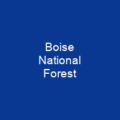Sawtooth National Forest: A Natural Gem in the Heart of Idaho
Imagine a vast, untouched wilderness stretching across 2,110,408 acres, where towering mountains and diverse ecosystems meet to create one of America’s most breathtaking natural landscapes. That’s what you get when you explore Sawtooth National Forest. Managed by the U.S. Forest Service since its establishment in 1905, this forest is a treasure trove of history, wildlife, and recreational opportunities.
The History Behind Its Name
But how did it get its name? The Sawtooth Mountains, which dominate the landscape, are named for their jagged peaks that resemble the teeth of a saw. This unique geological feature has been a landmark for travelers and adventurers alike since time immemorial.
A Brief Timeline: From Forest Reserve to National Forest
Let’s take a quick trip through history. The Sawtooth Forest Reserve was established in 1905, followed by the creation of the Cassia and Raft River Forest Reserves in 1906 and 1907 respectively. These reserves were later renamed to national forests on March 4, 1907. In 1936, Senator James Pope proposed establishing a national park within the Sawtooths, but it didn’t come to fruition.
The Forest’s Rich History and Modern Management
From its establishment as a forest reserve in 1905, Sawtooth National Forest has undergone numerous changes. In 1960, Senator Frank Church introduced legislation for a feasibility study to survey the area for national park status. This led to the creation of the Sawtooth National Recreation Area (SNRA) in 1972, which was dedicated on September 1st of that year.
Conservation and Management
The forest is managed by the U.S. Forest Service as four units: Fairfield, Ketchum, Minidoka, and SNRA. Conservation practices balance interests between recreation, preservation, and resource extraction. This approach ensures that visitors can enjoy the beauty of nature while also protecting it for future generations.
Wildlife and Ecosystems
The forest is home to over 243 bird species, 78 mammals, 28 reptiles and amphibians, and 29 fish. The Sawtooth Wilderness, originally designated in 1937 as the Sawtooth Primitive Area before becoming part of the National Wilderness Preservation System in 1972, is managed by the forest but only about a quarter of it lies within that forest.
Endangered Species and Invasive Species
The forest faces challenges from both invasive species and endangered ones. For instance, the Christ’s Indian paintbrush, Idaho’s rarest plant, is endemic to 200 acres on upper elevations of Mount Harrison in the Albion Mountains. Meanwhile, exotic species are often unintentionally introduced by people traveling from outside the forest and are usually found near roadways, campgrounds, and other areas used by people.
Recreation and Tourism
Sawtooth National Forest is a recreational paradise with over 1,000 miles of trails for hiking and backpacking. The SNRA offers mountain climbing and rock climbing opportunities, while rafting and kayaking are popular on the upper Salmon River. Lakes in the Sawtooth Valley have boat accesses, and hot springs are available to the public.
Winter Activities
In winter, visitors can enjoy downhill skiing, cross-country skiing, snowshoeing, and snowmobiling. Ski resorts and ski areas just outside the forest’s boundary offer grooming trails for cross-country skiers, as well as backcountry hut and yurt accommodations for overnight trips.
Scenic Byways
The forest is home to four of Idaho’s scenic byways, three of which intersect in Stanley. These byways provide stunning views and a chance to explore the beauty of the region at your own pace.
A Look into the Future: Challenges and Opportunities
While Sawtooth National Forest faces challenges such as invasive species and climate change, it also offers endless opportunities for exploration and conservation. The mountain pine beetle is a native insect that can cause large outbreaks, while zebra and quagga mussels pose potential threats to the forest’s aquatic ecosystems.
Conclusion
Sawtooth National Forest is more than just a place of natural beauty; it’s a living testament to the balance between human activity and environmental preservation. As we continue to navigate the complexities of modern conservation, this forest stands as a beacon of hope for what can be achieved when we respect and protect our natural world.

You want to know more about Sawtooth National Forest?
This page is based on the article Sawtooth National Forest published in Wikipedia (retrieved on December 11, 2024) and was automatically summarized using artificial intelligence.







